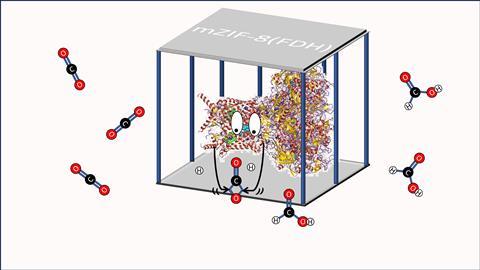
If you confine the enzyme FDH in a metal-organic framework (MOF) with magnetite, it is stable enough to be recycled after it has reduced CO2, as Argentinean researchers show in the journal Chemistry – A European Journal.
While humans are making great efforts to convert inert CO2 into something useful, nature has interesting nanomachines in the form of enzymes. The enzyme formate dehydrogenase (FDH) normally converts methanoate (formate) into CO2, but under certain conditions it does the opposite.
Matías Aguirre, Cristina Ramírez and Yesica Di Iorio from the Universidad Nacional de Mar del Plata wanted to take advantage of this. This had been tried before, for example by using the free enzyme or by binding it to a support, but the results were not satisfactory, so they took a different approach: they bound it to a metal-organic framework (MOF).
The MOF in question is ZIF-8, which is made up of zinc(II) ions and 2-methylimidazole molecules, and can be synthesised in water at room temperature. This comes in handy if you want to trap enzymes – which naturally occur in an aqueous environment – in a MOF. They also added magnetite (Fe3O4). During the synthesis process, small pieces of magnetite attach themselves to the MOF, making it possible to attract the MOF with a magnet.
The last thing needed was the biocatalyst NADH. This is because the CO2 conversion reaction is actually an equilibrium, with the reaction towards CO2 being favoured. With NADH, this equilibrium can be shifted in the other direction.
The researchers then compared the CO2 conversion of free FDH with the trapped variant [mZIF-8(FDH)], in which NaHCO3 (‘dissolved CO2’) was the CO2 source. This showed that the trapped mZIF-8(FDH) converted 3.4 times more CO2 than the free FDH (1015 vs. 300 µmol per litre per hour per milligram).
The magnetite decomposition also allows the whole thing to be recycled after the reaction. After three rounds of reaction, only 5% of the activity had been lost and after five rounds, 86% of the activity remained. All in all, the study provides an efficient and enzyme-friendly framework that could potentially be used for other enzymes too, the authors conclude.
Aguirre, M.E. et al. (2023) Chem. Eur. J. e202301113, DOI: 10.1002/chem.202301113












Nog geen opmerkingen